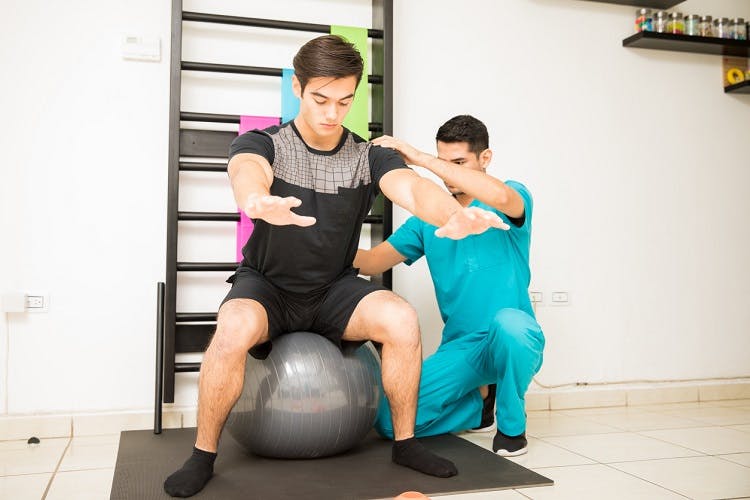Practicing core exercises can help spinal cord injury patients develop better balance and posture.
As its name suggests, the core is the center of the body and is responsible for balancing your upper and lower body movements.
Trunk paralysis is typically associated with cervical or thoracic level spinal cord injuries. However, all spinal cord injury patients can benefit from practicing core exercises.
This article will share 10 core exercises for spinal cord injury patients and easy ways to adjust them to better suit your functional abilities.
Why You Should Practice Core Exercises After Spinal Cord Injury
Before we get into the core exercises, it’s essential to understand that everyone is going to experience spinal cord injury and recovery differently. For your safety, seek clearance from your physician before starting any new exercise after spinal cord injury.
Depending on how severe your spinal cord injury is, the range of exercises you can perform will vary. While you may not be able to perform a certain exercise right now, it does not mean you never will. Recovery after spinal cord injury is possible.
Depending on the level of your injury and whether it is a complete or incomplete injury, you may be able to recover many of your functional skills. Because the spinal cord uses neuroplasticity, it may be able to make new connections so you can relearn functions through repetitive practice. Neuroplasticity is the spinal cord’s ability to rewire itself; however, only spared neural pathways (those left undamaged by SCI) at your level of injury are capable of it.
Every movement stimulates the spinal cord, so by consistently repeating movements, even if the movements are rather weak, your spinal cord will understand that there is a demand for that function and rewire itself. With continued practice, the rewired neural pathways will become stronger and the movement should feel more natural.
As a result, the more you practice core exercises for spinal cord injury rehabilitation, the more you’ll stimulate adaptive changes in the spinal cord to improve your balance and core strength.
Now that you understand that it is possible to strengthen your core after spinal cord injury, let’s get into the exercises.
Core Exercises for Spinal Cord Injury Patients

Weak core muscles can make everyday tasks difficult due to poor balance and posture. To improve your mobility, promote circulation, and minimize the risk of falling, you’re about to learn 10 core exercises for spinal cord injury patients.
Remember to ask your doctor or therapist if these exercises are appropriate for you, and be sure that you are completing all exercises safely. If you are struggling with maintaining your balance while sitting, have someone spot you while completing seated exercises.
- Deep breathing. Many people raise their shoulders and suck their stomachs in when asked to take a deep breath. However, this does not allow your lungs to fully expand. When you inhale, your diaphragm contracts, making more space in your chest cavity to allow your lungs to fully fill with air. If you are practicing deep, diaphragmatic breathing, you should be able to see and feel your abdomen rise with your inhales and fall with your exhales. This is easiest to practice lying on your back with your hand on your belly so you can feel it moving. Focusing on taking slow, deep breaths will help strengthen the core and increase oxygen intake to optimize body functions.
- Supine twist. Lie on your back with knees bent and feet flat on the floor or bed. Without moving your shoulders, slowly let the knees fall to one side, bring them back to center, and then twist to the other side.
- Crunches. Lie on the floor or on your mattress with feet planted about shoulder-width apart. Slowly lift your upper body forward and lower it gradually back down.
- Seated side crunch. While seated, tilt your upper body to one side and hold for 5 seconds. Return back to center and repeat to the other side. The lower body should not move at all.
- Crossbody leg lifts. Lie on the floor. Then, lift and tap your left foot with your right hand. Repeat with your right foot and left hand. If this is too difficult, lift and tap your elbow to the opposite knee.
- Trunk extension. Sit at the edge of your seat. Keep your back straight and engage your core muscles to slowly lean back until you tap the back on your seat. Hold for 5 seconds and then return to an upright position.
- Trunk twists. Sit at the edge of your seat and gently twist your torso side to side. The lower half of your body should not move.
- Figure 8s. Sit at the edge of your seat and slowly move your torso in a figure 8 motion. Switch directions (clockwise/counter-clockwise) every 3 rotations.
- Kneeling planks. Lie on your hands and knees on the floor. Adjust your body so there’s a straight downwards slope from your head to your knees. Hold for 20 seconds. If this is too difficult, bend your arms at the elbows and transfer the weight onto your forearms for greater stability.
- Seated marches. Sit on the edge of your seat and alternate lifting the knees. To make this more challenging, stand holding onto the back of your chair and complete marches in place.
Want 15 pages of SCI recovery exercises in PDF form? Click here to download our free SCI Rehab Exercise ebook now (link opens a pop up for uninterrupted reading)
Depending on the level and severity of your spinal cord injury, some core exercises may be more difficult than others. In the following section, we’ll discuss how to increase and decrease the difficulty levels of core exercises.
How to Adjust the Difficulty of Core Exercises

It’s essential to practice exercises that are effective for your specific ability level. They should be challenging enough to strengthen the muscles, but not so difficult that they make you want to give up. Likewise, they shouldn’t be so easy that you’re mindlessly performing them.
Below, we’ll go over 5 ways spinal cord injury patients can adjust the difficulty of core exercises:
- Add resistance. Hold any sort of weight or utilize wrist or ankle weights while performing core exercises. This will increase tension on the muscles and strengthen them.
- Perform passive exercises. Passive exercises do not require the patient to exert any energy. Instead, a caregiver or physical therapist will move the patient’s body for them. This kind of exercise is ideal for SCI patients with severe paralysis that are unable to move their bodies on their own. Passive exercise helps improve circulation, maintain flexibility in the joints, and stimulate the spinal cord.
- Use a stability ball. A stability ball will make any seated exercise more challenging because it requires you to consistently adjust your center of gravity.
- Adjust the number of repetitions and sets. By decreasing the number of repetitions between sets, the muscles will be less likely to fatigue. In contrast, adding more repetitions will increase muscle strain.
- Use adaptive tools. Ask your physical therapist about adaptive tools that can help prevent injuries and make core exercises easier to perform. For example, wearing a grip band can help those with poor hand control hold onto objects and add resistance during core exercises.
You’ll notice the best improvements when you adjust core exercises to your unique ability levels.
Core Exercises for Spinal Cord Injury Patients: Key Points
Whether your trunk is paralyzed or not, all spinal cord injury patients can benefit from practicing core strengthening exercises.
SCIs will result in different functional outcomes, so it’s important to adjust exercises to fit your abilities. Practicing core exercises that are too difficult can be discouraging while those that are too easy will not result in any progress.
Finding the right amount of challenge will strengthen the core muscles and allow you to gradually improve.
We hope this article inspired you to continue pursuing spinal cord injury rehabilitation and try some of these core exercises for yourself. Good luck!
Photos from top to bottom: iStock/Antonio_Diaz/KatarzynaBialasiewicz











